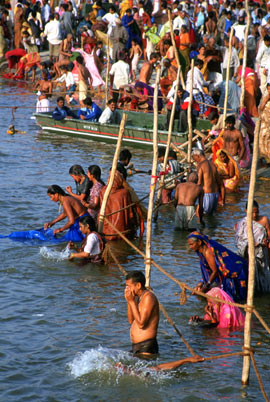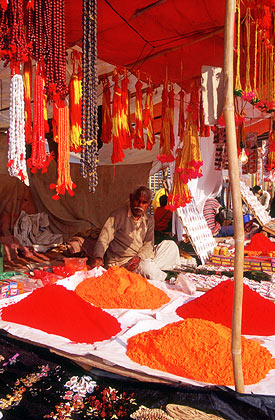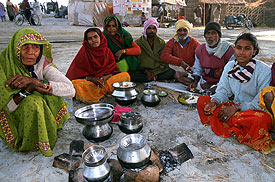|
| |
Rich and poor traveled great distances and, in many cases, at great hardship to attend the kumbh. With each passing day, the roads, rail stations and airport that serve Allahabad became more and more clogged with travelers who streamed to the festival site over pontoon bridges, inching their way to a favored guru's camp or an unclaimed spot on the sandy river bed. Although a religious conclave, a festive atmosphere prevailed over the event. Vendors enticed passing pilgrims with colorful displays of bangles, beads and ornamental powders spread out on blankets, while young boys sold wooden flutes and pinwheels, and cries of "chai" came from turban-wearing tea sellers.
The timing of the Kumbh Mela in Allahabad is correlated to a specific alignment of the moon, the sun and the planet Jupiter. This year's festival was particularly auspicious because it was the first Kumbh Mela of the millennium and it marked the 12th anniversary of the event's 12-year cycle. As such, it attracted the greatest number of
devotees, by far, in the history of the religious spectacle. In fact, on the most sacred of six bathing days, an estimated 30 million people crowded into the sprawling, riverside flood plain, creating what is believed to be the largest gathering of people at any one time in the world.
To control this cast of millions, Indian authorities erected corral-type pens to hold back the tide of pilgrims who might have otherwise rushed the
most significant bathing sites at the most auspicious time to do so. |
 |

Bathing, Kumbh 2001
|
|
| |
 Ornamental Powders, Kumbh 2001
Ornamental Powders, Kumbh 2001 |
  |
In the dark, pre-dawn hours of January 24, most in this mass of humanity waited their respective turns to take a "dip" in the waters where the Ganges, Yamuna and mythological Saraswati rivers converge. Traditionally, the Nagas have had distinction of leading the charge into the sangam at the ideal astrological moment. Wielding sabres and spears symbolic of their militant, monastic order, the naked, ash-smeared Hindu ascetics were given plenty of room by police to immerse themselves, from shaved or matted head to toe, in the sacred waters.
Then came a regal procession of India's great mystics - saints, sadhus, holy men, gurus, swamis. Draped with brightly colored fabrics and adorned with floral garlands, tractor-pulled platforms carrying the religious royalty rolled up to the
water's edge where the saints climbed down from their red-velvet thrones to take the ritual plunge.
Following the parade of sages, the river was transformed into a sea of devotees who stood shoulder to shoulder, hands reverently clasped in prayer,
their eyes revealing the depth of their devotion. Many of the faithful carried jugs into the water, hoping to bottle its soul-saving properties.
"This is the biggest religious meet in the world. All the saintly figures have joined hands," said Allahabad resident and businessman Rajesh Bagga. The head of one of the city's more prominent families, Bagga is a devotee of Maruti Ram Baba whose camp fed an estimated 15,000 poor and hungry people every day during the six-week Kumbh Mela.
|
|
"In the Hindu community," Bagga said, "feeding the needy is the way to salvation."
Such acts of charity were common throughout the hundreds of Akhara (sect) camps that were set up within the grid-like quadrants of the expansive kumbh districts. Paid for by families of means associated with particular gurus, food and medicine were dispensed to the needy who lined up to be fed or examined by physicians.
At the camp sponsored by Mahadevi Nadchatiram and Saraswathy Devi, two Malaysian attorneys and devotees of Mahamandeleshwarar Bramarishi Rasanandji, Dr. Varinder Brar and an associate examined an estimated 4,000 people during the first two weeks of the kumbh.
|
 |
 Family Meal, Kumbh 2001
Family Meal, Kumbh 2001 |
 Devotees, Kumbh 2001
Devotees, Kumbh 2001 |
  |
"Many suffer from respiratory problems," said Dr. Brar of the poorer pilgrims who otherwise would not likely see a doctor in their rural homes. "The medicine we give them is paid for by Madame (Nadchatiram)," he said.
In addition to food and medicine, the guru-led camps dispensed teaching and encouraged learning.
Striped, multi-colored tents, some large enough to accommodate several hundred devotees, were pitched on the festival grounds for the purpose of promoting religious discourse and cultural activities. Many of the larger, more elaborate camps were set up like compounds with huge, storybook-like facades trimmed in lights and decorated with poster-size murals of resident gurus. From within, what seemed like a perpetual play list of top-40 chants and religious refrains was broadcast on loudspeakers into the festival airspace.
In the early evening, as the setting sun neared the horizon, smoke from burning campfires and dust stirred up from the sandy riverbed combined to create an oppressive haze over the festival site. But the atmospheric condition didn't seem to faze the multitude of pilgrims ... nothing that a "dip" in the sangam couldn't cure. After all, what's a little dust when you've washed away the sins of a lifetime.
|
|
